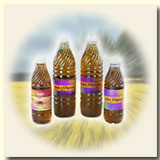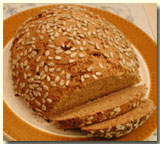|
|
SESAME UTILIZATION
The world production of sesame seed is almost wholly utilized for culinary purposes. In India, most of the seeds (about 78%) are used for oil extraction, and about 20% are used for domestic purposes such as preparation of sweetmeats and confectionery. Sesame oil is mostly used as a cooking medium. Only a small proportion of low-grade oil is used in the industrial sector.
Human Food
 Sesame seeds, which have a nutty, slightly sweet flavor, are thought to be one of the oldest condiments, and so appealing that they became an integral part of the varied cuisines throughout the Middle East where they were native. Sesame seeds, which have a nutty, slightly sweet flavor, are thought to be one of the oldest condiments, and so appealing that they became an integral part of the varied cuisines throughout the Middle East where they were native.
"The butter of the Middle East," TAHINI, a smooth, creamy paste made of toasted, ground hulled sesame seeds, is a centuries-old traditional ingredient in Middle Eastern cooking. Hummus, a Middle Eastern appetizer that has become a universal favorite is made of ground chickpeas, garlic, lemon juice, salt, and tahini. Baba ghanoush, another favorite appetizer known throughout the Middle East, has a base of roasted eggplant seasoned with tahini, lemon juice, garlic, and salt. These sesame-based dishes have been handed down from generation to generation for centuries.
Moreover, one taste of the sweet, delectable HALVA, a sesame and honey confection that originated in Turkey and you'll easily understand the allure that sesame seeds held to cultures of the ancient Middle East.
In Western and Oriental bakeries, sesame seed is used as a garnish on bread and bread sticks, health snacks (such as sesame bars), in prepared breakfasts (as an additive to cereal mixes), on breakfast crackers, pies and pastry products.
In India, sesame seeds are often made into sweetmeats (laddu and chikki). They are roasted and ground into meal and made into cakes. Confections made from sesame seeds are commonly available in the Indian market. Also, Chinese confectioners have long favored the use of sesame seeds as a coating on their deep-fried sweets.
In the Japanese Buddhist monasteries, the sesame seed plays a most important role in shojin-ryori, a vegetarian cooking. There the sesame seeds are almost always toasted before using as a sprinkle over rice dishes. Gomashio, a seasoning made of crushed sesame seeds and salt, is frequently served at the table in Japanese homes to be added as enhancement to the dishes served. If you are an aficionado of Japanese cuisine, you've probably encountered the delightful sesame flavor in traditional dipping sauces served in their restaurants.
In the African's diet, sesame seeds enter in various forms such as soups and confections.
In Latin America, sesame seed cakes are traditional items of food.
Oil
 Oil is the major product of sesame seed processing. Most of the oil produced is used for culinary purposes. It is a common constituent of the Asian dishes and is used in frying, roasting and stewing of meat, fish and vegetables. Its nutty flavor is appreciated. The oil has excellent stability and keeps well at room temperature for 2-3 months. Because of its quality and high price, sesame oil is frequently adulterated with groundnut, rape or cottonseed oils. Sesame oil can be readily hydrogenated to medium melting fats of different textures for use in margarine and shortenings. Oil is the major product of sesame seed processing. Most of the oil produced is used for culinary purposes. It is a common constituent of the Asian dishes and is used in frying, roasting and stewing of meat, fish and vegetables. Its nutty flavor is appreciated. The oil has excellent stability and keeps well at room temperature for 2-3 months. Because of its quality and high price, sesame oil is frequently adulterated with groundnut, rape or cottonseed oils. Sesame oil can be readily hydrogenated to medium melting fats of different textures for use in margarine and shortenings.
Cake & Meal
 After the sesame oil is pressed out of the seed, the resulting residue is referred to as a seed cake that is very high in protein. A portion of this nutritious seed cake is used as animal feed, while the remainder is ground into sesame meal (flour) and added to health foods. It is also used as functional ingredient in meat products due to the high cost and scarcity of meat in some countries. After the sesame oil is pressed out of the seed, the resulting residue is referred to as a seed cake that is very high in protein. A portion of this nutritious seed cake is used as animal feed, while the remainder is ground into sesame meal (flour) and added to health foods. It is also used as functional ingredient in meat products due to the high cost and scarcity of meat in some countries.
Animal Feed
Defatted sesame meal is traditionally used for animal feed. The cake is a valuable stock feed. It is rich in protein, calcium, phosphorus and niacin. The cake is well liked by the stock and keeps well in storage. It is rich in methionine and is a valuable supplement to soybean meal in livestock diets.
Industrial Uses
Sesame oil is used in the pharmaceutical, soap, perfumery and cosmetic industries.
It forms the basis of most of the fragrant or scented oils and it is not liable to turn rancid or solidify and it does not possess objectionable taste or odor. In the perfumery industry, sesame oil is used as a fixative. In India, sesame oil is used for conditioning the skin making it smooth, brilliant and pathogen free.
There are numerous medical applications of sesame. The seeds milled and mixed with brown sugar are eaten by nursing mothers to encourage their milk production. Sesame oil is also used as a remedy for coughing and throat pain. When taken internally in a sufficient dose, sesame oil acts like laxative.
The oil has synergistic activity with insecticides such as rotenone ad pyrethrins.
Sesame oil is also used in the production of paints and lubricants.
|

